The year 1603 marked the end of the Elizabethan era, making way for James I and the house of Stewart. The new century would be a troubled one with the upheaval of civil war, a plague epidemic and the great fire of London. However, it did not limit great artistic progress. The baroque period flourished in Europe from 1600 to 1750, influencing artists in England in spite of the political bloodshed. This article will explore some of the most prominent artists of the 17th century.
 Above: portrait of Charles I by Daniël Mijtens (1629), engravings of Oliver Cromwell and Charles II, miniature of John Churchill the First Duke of Marlborough (late 1600s), portrait of Queen Henrietta Maria by Anthony Van Dyck (1636), miniature of Dr. Brian Walton by John Hoskins (1657) and a miniature of Henry Carey Samuel Cooper (1649)
Above: portrait of Charles I by Daniël Mijtens (1629), engravings of Oliver Cromwell and Charles II, miniature of John Churchill the First Duke of Marlborough (late 1600s), portrait of Queen Henrietta Maria by Anthony Van Dyck (1636), miniature of Dr. Brian Walton by John Hoskins (1657) and a miniature of Henry Carey Samuel Cooper (1649)
Nathaniel Bacon (1585-1627)
Rather than the usual portraiture practiced by English 17th century artists, Nathaniel Bacon had a focus on genre paintings, typically found in Dutch and Flemish schools. Bacon’s large scale still life painting entitled Cookmaid with Still Life of Vegetables and Fruit is a prominent piece owned by Tate Britain.
William Larkin (1580-1619)
As a portraitist during the reign of James I, William Larkin is known for recording detailed and opulent costumes of the Jacobean period. Born in London, Larkin worked for many aristocratic patrons of the era, often surrounding their figure with sumptuous drapery in the form of curtains.
 Above: three portraits by William Larkin from the 1610s
Above: three portraits by William Larkin from the 1610s
Francis Cleyn (1582-1658)
Cleyn was originally from Germany and was at first a tapestry designer for the court of Christian IV of Denmark. After studying in Italy, he went to England where James I placed him in the new Mortlake Tapestry Works. Here, he reproduced pieces by Raphael for Charles I, as well as mythological scenes for palaces and estates across England.
John Hoskins (1589-1664)
An uncle to Samuel Cooper, John Hoskins was also an accomplished miniaturist. Originally from Wells, his work was influenced by the mastery of Nicholas Hilliard.
 Above: The Destruction of the Children of Niobe after a design by Franis Cleyn (1650-70) and a miniature of Endymion Porter by John Hoskins (1630)
Above: The Destruction of the Children of Niobe after a design by Franis Cleyn (1650-70) and a miniature of Endymion Porter by John Hoskins (1630)
Robert Walker (1599-1658)
Robert Walker was a leading artist during the parliamentarian rule of England. His most notable works are portraits of Oliver Cromwell and parliamentarian generals.
Cornelius Johnson (1593-1661)
Born in London, Johnson was artistically influenced by his family’s Dutch origins. His work as a portraitist in London came to a halt at the outbreak of civil war, causing him to flee to The Netherlands with his family to avoid persecution for his links to English aristocracy. However, once he set up a studio in Amsterdam and later Utrecht, his work continued for various English patrons who were also living in exile.
 Above: three portraits by Cornelius Johnson from the first half of the 17th century
Above: three portraits by Cornelius Johnson from the first half of the 17th century
John Souch (1593-1645)
Popular in the North West of England, John Souch was an apprentice to the first of the Randle Holme family of heraldic artists in Chester. Although he trained in the painting of funerary hatchments, Souch also branched out into portraiture. A painting that combines both of his artistic genres is a portrait of Sir Thomas Aston at the deathbed of his wife, now housed at Manchester City Art Gallery.
Anthony van Dyck (1599-1641)
One of the most famous names in 17th century art, Anthony van Dyck was the court painter to many European royal families and a favourite of King Charles I, who presented him with a knighthood for his work. Born in Antwerp, Van Dyck showed artistic talent from a very early age and by 15 he was already established as a painter, setting up a workshop with Jan Brueghel the Younger.
 Above: a selection of portraits by Anthony van Dyck, including a self portrait (centre right)
Above: a selection of portraits by Anthony van Dyck, including a self portrait (centre right)
In his formative years, the young artist worked for Peter Paul Rubens and Hendrick van Balen the Elder, both of whom influenced his Flemish baroque style. Anthony van Dyck’s association with the English monarchy created a tradition in royal portraiture that would inspire artists for at least a century.
 Above: detail from Virgin and Child with Saint Catherine of Alexandria by Anthony van Dyck, 1630
Above: detail from Virgin and Child with Saint Catherine of Alexandria by Anthony van Dyck, 1630
Unfortunately, Van Dyck’s career was cut short when he died in London aged 42. His tomb was commissioned by the king and he was buried at St Paul’s Cathedral. This memorial would be destroyed two decades later in the Great Fire of London.
Wenceslaus Hollar (1607-1677)
Born in Prague, Hollar became a prominent engraver working under Matthäus Merian. His work was noticed by Thomas Howard, 21st Earl of Arundel during a diplomatic visit, who employed him as a draftsman. He journeyed to England, where he worked for various aristocrats before the Civil War broke out. Joining the Royalists, Hollar was caught up in the siege of Basing House, where he continued to produce prints even in the most drastic of circumstances.
 Above: a selection of engravings by Weceslaus Hollar including a self portrait holding one of his prints
Above: a selection of engravings by Weceslaus Hollar including a self portrait holding one of his prints
William Faithorne (1616-1691)
Like Wenceslaus Hollar, Faithorne was also held up in Basing House during the Civil War. He was a painter and engraver, completing a large map of London that is today an important geographical record of the city prior to the great fire of 1666.
William Dobson (1611-1646)
Born in London, Dobson was a leading portraitist based in Oxford during the civil war, where he painted numerous Royalist cavaliers.
 Above: a chalk drawing by William Faithorne and a family portrait by William Dobson
Above: a chalk drawing by William Faithorne and a family portrait by William Dobson
Samuel Cooper (1609-1672)
A famous miniaturist, Samuel Cooper was a resident of Covent Garden where he often attended the fashionable coffee houses frequented by the likes of writers, artists and aristocrats of the era. Cooper’s unfinished portrait of Oliver Cromwell is one of his best known works.
Richard Gibson (1615-1690)
Richard Gibson was a celebrated court dwarf who created miniatures for several royal courts, from Charles I to William and Mary. Gibson married Anne Shepherd, a court dwarf to Queen Henrietta Maria, the pair had nine children – many becoming artists themselves, including Susan Penelope Rosse.
 Above: three miniatures by Samuel Cooper (left) and two by Richard Gibson (right)
Above: three miniatures by Samuel Cooper (left) and two by Richard Gibson (right)
John Michael Wright (1617-1694)
Training under George Jamesone in Edinburgh, John Michael Wright was a leading portraitist under Charles II and James II. Wright travelled in France and Italy and this is evident in the academic style of his work – this early adoption of the ‘grand tour’ allowed him to study the masters of the Italian renaissance, as well as classical artefacts. His artwork was so admired that both Parliamentarian and Royal patrons could ignore his Roman Catholic status. Wright completed several famous portraits of Charles II, but was never appointed as the Kings Painter due to his favour for realism above the flattering glamour afforded by the work of Peter Lely.
 Above: paintings by Francis Barlow and John Michael Wright
Above: paintings by Francis Barlow and John Michael Wright
Following the great fire in 1666, John Michael Wright was commissioned by the City of London to paint 22 full portraits of the men tasked with assessing the cause of the disaster, known as the ‘fire judges’. After the removal of James II in 1688, Wright no longer received royal patronage – perhaps in part due to his religious leanings in what was now a stubbornly protestant court. He died six years later in near-poverty.
Francis Barlow (1626-1704)
Francis Barlow was a printmaker and artist, his work features hunting scenes, political cartoons, book illustrations and even playing cards.
Isaac Fuller (1606-1672)
Fuller was known for his interior painting, completing decorative work for Magdalen and All Souls Colleges at Oxford University. He also completed five panels depicting the escape of Charles II after the Battle of Worcester.
 Above: drawing by Isaac Fuller and a portrait of Isaac Fuller by Edward Pierce, 1670
Above: drawing by Isaac Fuller and a portrait of Isaac Fuller by Edward Pierce, 1670
Joan Carlile (1606-1679)
One of the first professional female artists, Joan Carlile’s portrait of Lady Dorothy Browne and Sir Thomas Browne is housed at The National Portrait Gallery. Carlile’s family were involved with the upkeep of the Royal Parks under Charles I and during the Civil War period.
Peter Lely (1618-1680)
Taking over from the position of Anthony van Dyck as the King’s Painter, Lely continued the tradition of Dutch baroque art in the English court. Lely’s work was so prolific that supply could not always keep up with the demand, to ease the process Lely had a vast team of apprentices who would paint various numbered poses, whilst he completed only the head and hands.
 Above: two portraits by Peter Lely, Diana Kirke Countess of Oxford (1665) and Sir Ralph Bankes (1660)
Above: two portraits by Peter Lely, Diana Kirke Countess of Oxford (1665) and Sir Ralph Bankes (1660)
Lely’s most famous series of portraits is the ‘Windsor Beauties’. The flattering three-quarter length depictions of the ladies in Charles II’s court include several of the king’s mistresses. The portraiture of celebrated and notorious figures from the revelrous court of Charles II attracted a market for mezzotint reproductions. Peter Lely died at his easel in 1680, whilst completing a portrait of the Duchess of Somerset. His death left many unfinished paintings, many of which were finished by his workshop at a later date.
 Above: detail from portrait of Mary Capel and her sister Elizabeth by Peter Lely, mid 17th century
Above: detail from portrait of Mary Capel and her sister Elizabeth by Peter Lely, mid 17th century
John Hayls (1600-1679)
John Hayls was influenced by the work of Van Dyck, he is best known for his portrait of the writer Samuel Pepys, making an appearance in his famous diary of 1666.
Mary Beale (1633-1699)
As well as being a talented portraitist, Mary Beale also provided her unique perspective on the art world through writing. Born in Suffolk, her workshop was in Covent Garden, where she would have been a neighbour to Joan Carlile.
 Above: two paintings by Mary Beale and a portrait of the artist (centre) with her son Charles
Above: two paintings by Mary Beale and a portrait of the artist (centre) with her son Charles
Beale’s talent was noticed by Peter Lely and she produced copies of his work, as well as some of his Old Masters collection that he had loaned for her to practise from. Lely commented positivity that she “worked with a wonderful body of colour, and was exceedingly industrious.” Mary Beale was popular with both Royalist and Parliamentarian patrons throughout the mid 17th century, allowing her to support her family as the main breadwinner.
Antonio Verrio (1636-1707)
Antonio Verrio’s work can be found in palaces and estates across England. Famous for bringing the fashion for grand baroque interiors over with him from the Kingdom of Naples, Verrio quickly attracted the attention of Charles II and went on to work for James II. However, due to the Glorious Revolution, Verrio had to leave court due to his Catholicism. He was later reinstated to decorate Hampton Court Palace for William III.
 Above: close up of James II Receiving the Mathematical Scholars of Christ’s Hospital by the studio of Antonio Verrio
Above: close up of James II Receiving the Mathematical Scholars of Christ’s Hospital by the studio of Antonio Verrio
John Greenhill (1644-1676)
A pupil of Peter Lely, Greenhill was from Salisbury and worked in Covent Garden. Although he showed great skill in his copies of Lely and Van Dyck’s work, his life was cut short after falling into a London gutter whilst intoxicated.
Peter Cross (1645-1724)
Cross was a skilled miniaturist. Though he worked throughout the late 17th century, his work was at its height of popularity during the reign of Queen Anne. His name was confused by various writers, so his work is sometimes listed as being by Lawrence Cross or Lewis.
 Above: a pastel portrait of Phillip Woolrich by John Greenhill and two miniatures by Peter Cross
Above: a pastel portrait of Phillip Woolrich by John Greenhill and two miniatures by Peter Cross
Jacob Huysmans (1633-1696)
Huysmans was known for his opulent portraits. Born in Antwerp, he trained under Gillis Backereel and Frans Wouter before moving to England in the 1660s. In the English court, he was a favourite of Queen Catharine of Braganza, who favoured his elaborate style and Catholic faith.
Sir Godfrey Kneller (1646-1723)
A pupil of Rembrandt and Ferdinand Bol, Kneller was introduced to the English court through patronage of Charles II’s illegitimate son, the Duke of Monmouth. In similar fashion to Peter Lely, Kneller had a very busy studio that composed portraiture on an almost industrial scale through the use of standardised poses that could be subtly changed for each sitter.
 Above: three paintings by Kneller including a self portrait (centre) from 1672-73
Above: three paintings by Kneller including a self portrait (centre) from 1672-73
After Lely’s death, Kneller took up the position of Principal Painter in Ordinary to the crown. During this period he composed the Hampton Court Beauties, similar to the Windsor Beauties of his predecessor, as well as the portraits of 48 leading politicians known as the Kit-Cat Club. His work would be influential to artists of the English court in the 18th century, especially the first president of the Royal Academy, Joshua Reynolds.
 Above: three mezzotints after portraits by Godfrey Kneller
Above: three mezzotints after portraits by Godfrey Kneller
John Riley (1646-1691)
Studying under Isaac Fuller and Gerard Soest, John Riley was born in London and was a grandson to the keeper of the records in the Tower of London. Although Charles II once remarked of his portrait by Riley “Is this like me? Oddsfish, then I’m an ugly fellow!” His work was popular with the English court. Later in his career, Riley was made Principal Painter in Ordinary alongside Kneller.
 Above: a painting by John Riley, mezzotint portrait of Grinling Gibbons after Kneller, and one of Gibbons statues depicting James II in the style of a Roman emperor
Above: a painting by John Riley, mezzotint portrait of Grinling Gibbons after Kneller, and one of Gibbons statues depicting James II in the style of a Roman emperor
Grinling Gibbons (1648-1721)
Famous for his sculptural work, Gibbons created interior decoration as well as statuary. Originally from Rotterdam, Gibbons was one of many artists working in London of Dutch origin. He was quickly recognised for his skill and became the King’s Carver, completing work for St Paul’s Cathedral under Christopher Wren, as well as Windsor Castle. Gibbons lived in Deptford, an area that still commemorates his residence to this day with a primary school named after him.
 Above: three portraits by Willem Wissing
Above: three portraits by Willem Wissing
Willem Wissing (1656-1687)
Willem Wissing was an assistant to Peter Lely, having moved to London after studying in The Hague under Willem Doudijns. He had many royal and aristocratic patrons for his portraits and worked alongside Jan van der Vaart, who painted the landscape and drapery elements in his portraits.
Marmaduke Cradock (1660-1716)
Unlike many of the 17th century artists on this list, Marmaduke Cradock composed paintings of nature and wildlife rather than typical portraiture of the era. His paintings of birds were especially admired by collectors.
 Above: detail from a painting by Marmaduke Cradock, 1700
Above: detail from a painting by Marmaduke Cradock, 1700
Catherine da Costa (1679-1756)
Catherine da Costa was a miniaturist working in London. She was of Portuguese Jewish heritage, her parents having fled to England due to the Spanish Inquisition.
Jonathan Richardson (1667-1745)
Richardson was an apprentice to John Riley, practising portraiture in a style that would go onto influence Thomas Hudson and Joshua Reynolds. His publication of An Essay on the Theory of Painting is one of the earliest forms of art theory produced in English.
 Above: three portraits by Jonathan Richardson
Above: three portraits by Jonathan Richardson
Anne Killigrew (1660-1685)
A poet and a portraitist, Anne Killigrew was born in London to a creative family of musicians and playwrights. In 1686, she died aged just 25. John Dryden wrote a famous ode to her many talents.
James Thornhill (1675-1734)
Muralist James Thornhill is best known for the painted hall at the Old Royal Naval College in 1707, as well as the Dome at St. Paul’s Cathedral and The Sabine bedroom at Chatsworth House. Born in Melcombe Regis, Dorset, he was the first British artist to be knighted.
 Above: two allegorical paintings attributed to James Thornhill depicting the power of Great Britain by sea and land, 1720
Above: two allegorical paintings attributed to James Thornhill depicting the power of Great Britain by sea and land, 1720
How can we help?
Our conservation team is happy to offer advice and assist you with any restoration concerns including paintings from 17th century artists. Email us via [email protected] or call 0207 112 7576

 Above: portrait of Charles I by Daniël Mijtens (1629), engravings of Oliver Cromwell and Charles II, miniature of John Churchill the First Duke of Marlborough (late 1600s), portrait of Queen Henrietta Maria by Anthony Van Dyck (1636), miniature of Dr. Brian Walton by John Hoskins (1657) and a miniature of Henry Carey Samuel Cooper (1649)
Above: portrait of Charles I by Daniël Mijtens (1629), engravings of Oliver Cromwell and Charles II, miniature of John Churchill the First Duke of Marlborough (late 1600s), portrait of Queen Henrietta Maria by Anthony Van Dyck (1636), miniature of Dr. Brian Walton by John Hoskins (1657) and a miniature of Henry Carey Samuel Cooper (1649)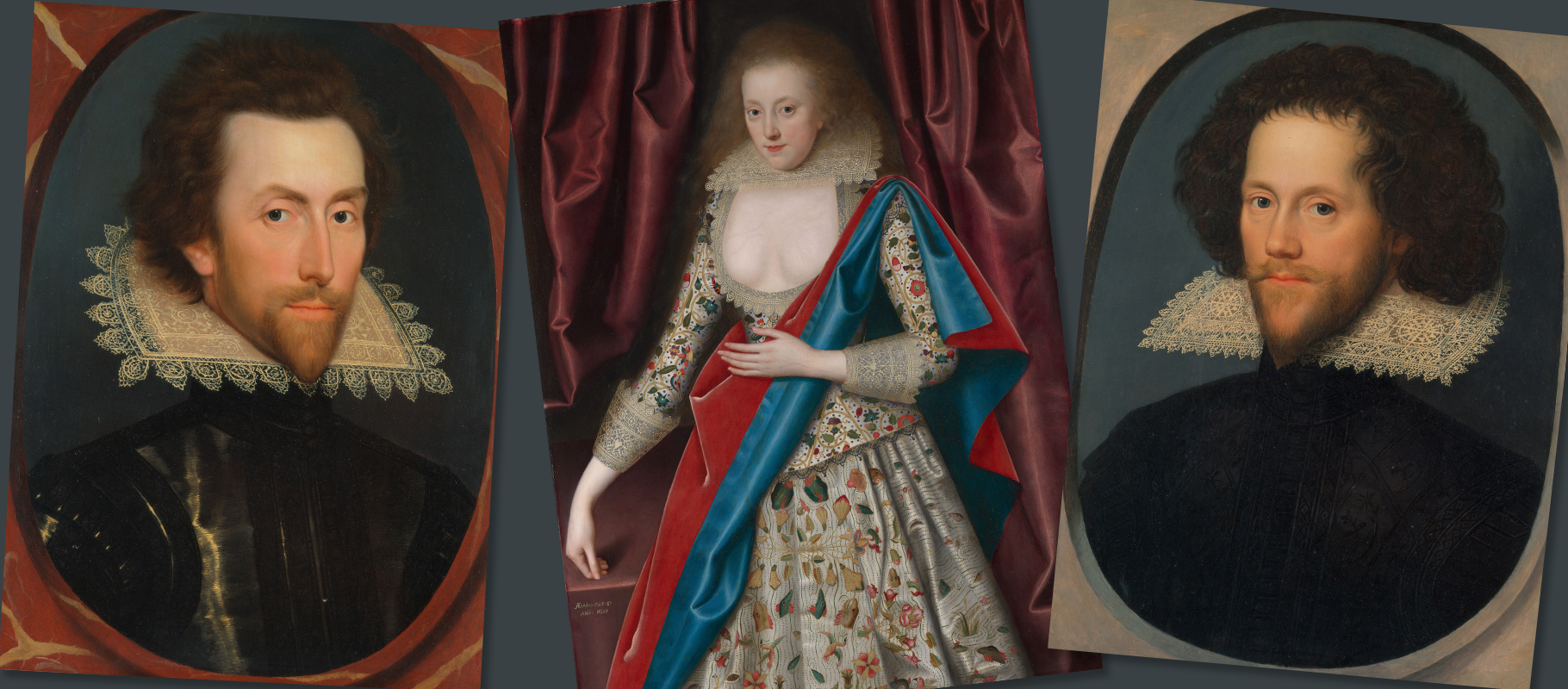 Above: three portraits by William Larkin from the 1610s
Above: three portraits by William Larkin from the 1610s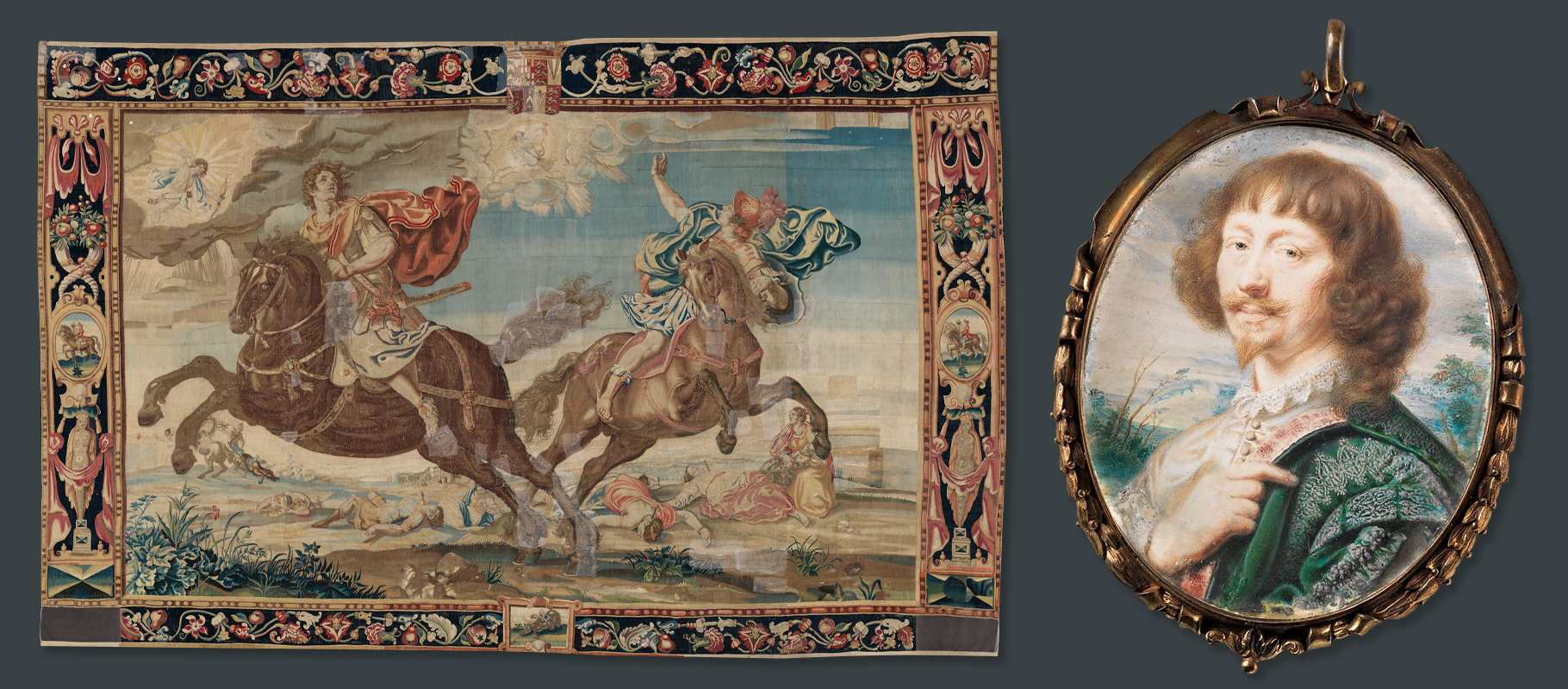 Above: The Destruction of the Children of Niobe after a design by Franis Cleyn (1650-70) and a miniature of Endymion Porter by John Hoskins (1630)
Above: The Destruction of the Children of Niobe after a design by Franis Cleyn (1650-70) and a miniature of Endymion Porter by John Hoskins (1630)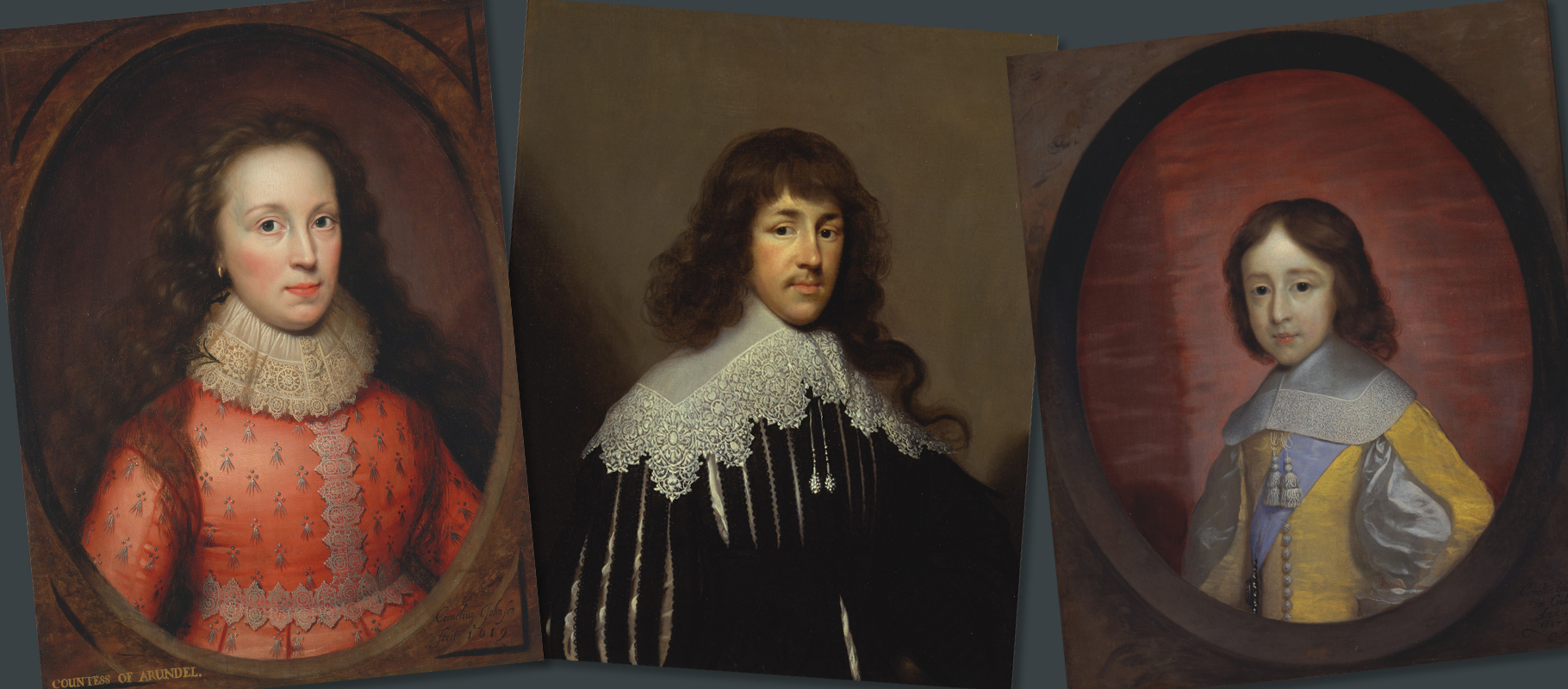 Above: three portraits by Cornelius Johnson from the first half of the 17th century
Above: three portraits by Cornelius Johnson from the first half of the 17th century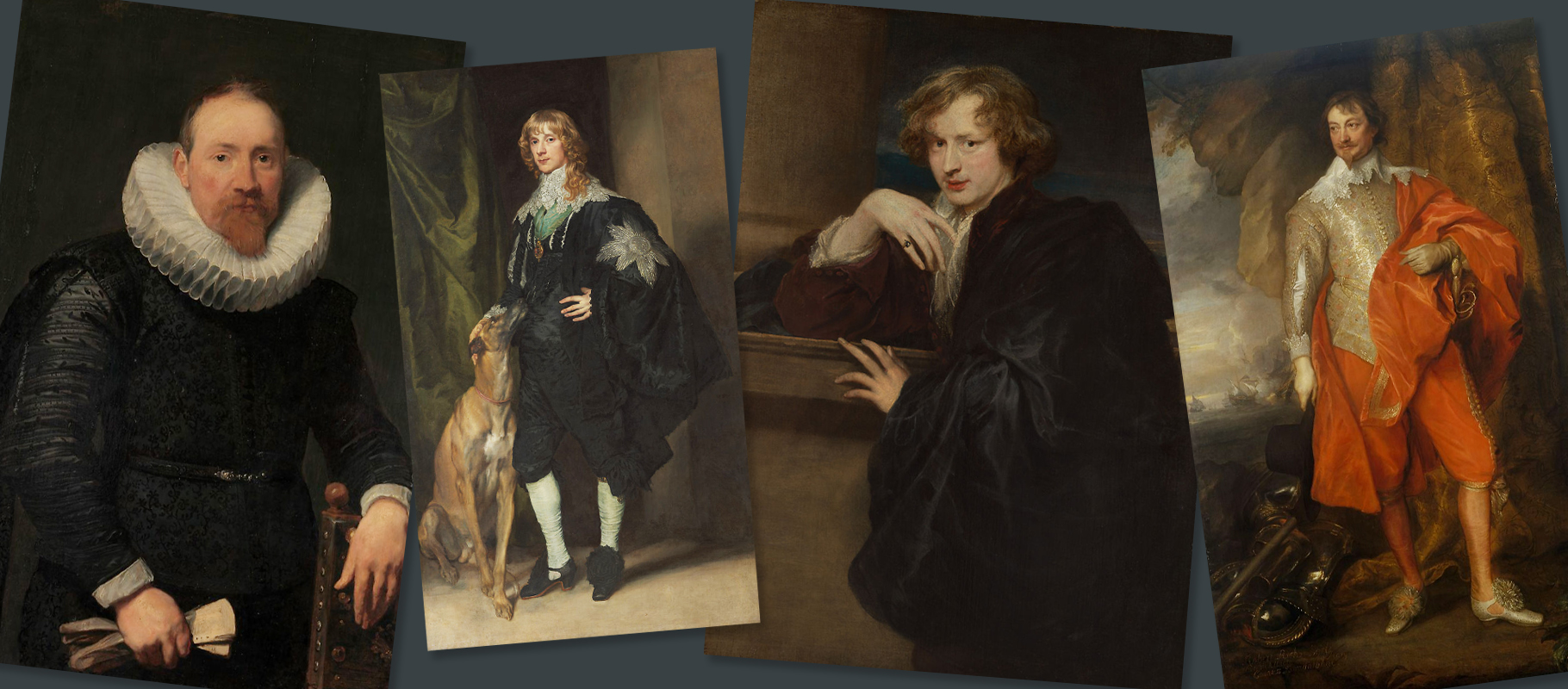 Above: a selection of portraits by Anthony van Dyck, including a self portrait (centre right)
Above: a selection of portraits by Anthony van Dyck, including a self portrait (centre right)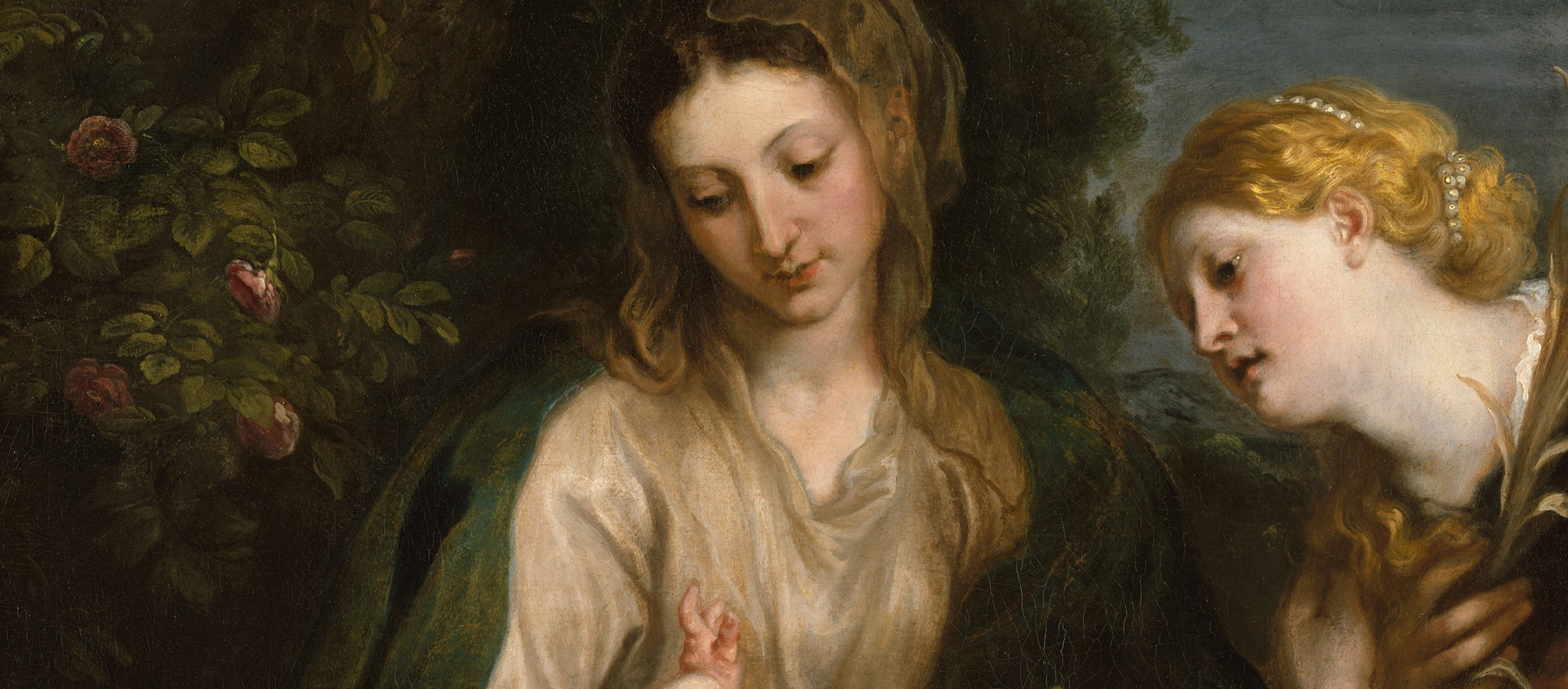 Above: detail from Virgin and Child with Saint Catherine of Alexandria by Anthony van Dyck, 1630
Above: detail from Virgin and Child with Saint Catherine of Alexandria by Anthony van Dyck, 1630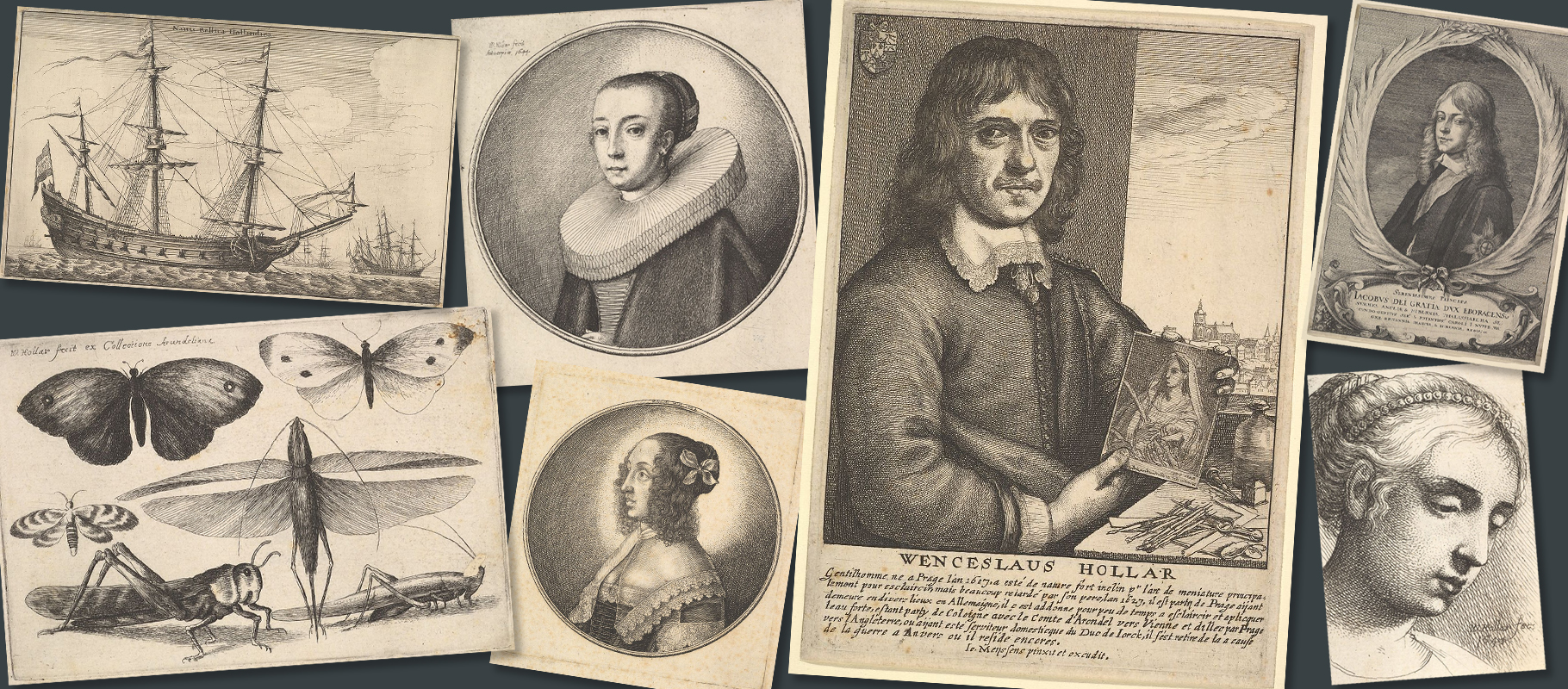 Above: a selection of engravings by Weceslaus Hollar including a self portrait holding one of his prints
Above: a selection of engravings by Weceslaus Hollar including a self portrait holding one of his prints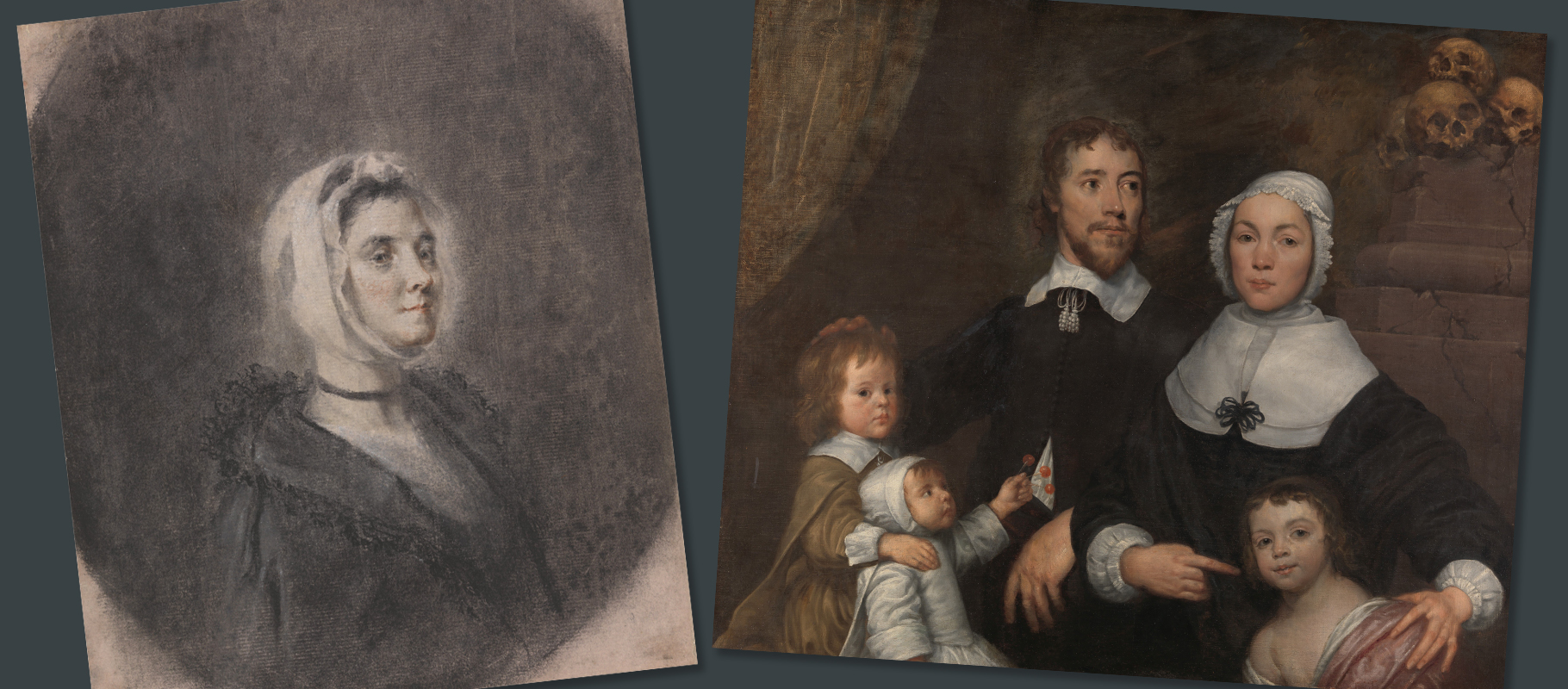 Above: a chalk drawing by William Faithorne and a family portrait by William Dobson
Above: a chalk drawing by William Faithorne and a family portrait by William Dobson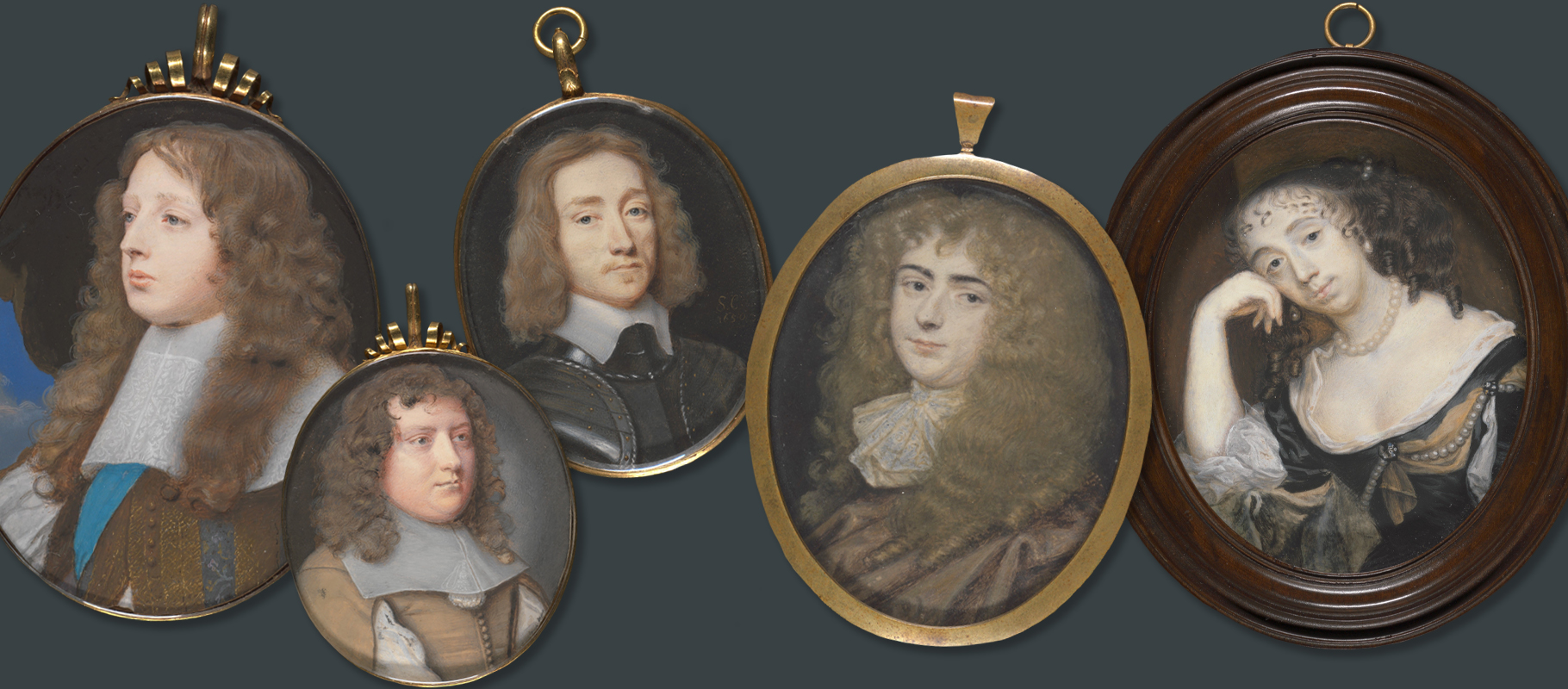 Above: three miniatures by Samuel Cooper (left) and two by Richard Gibson (right)
Above: three miniatures by Samuel Cooper (left) and two by Richard Gibson (right)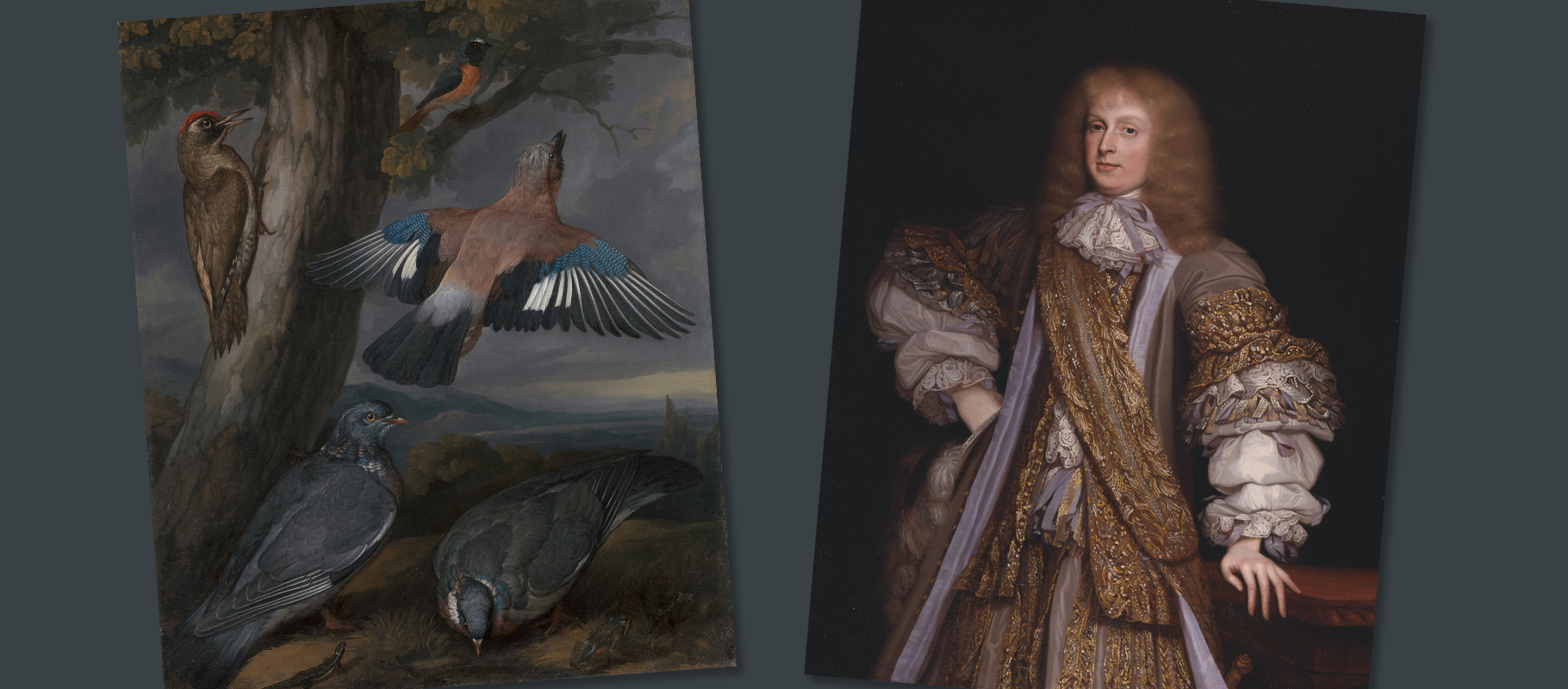 Above: paintings by Francis Barlow and John Michael Wright
Above: paintings by Francis Barlow and John Michael Wright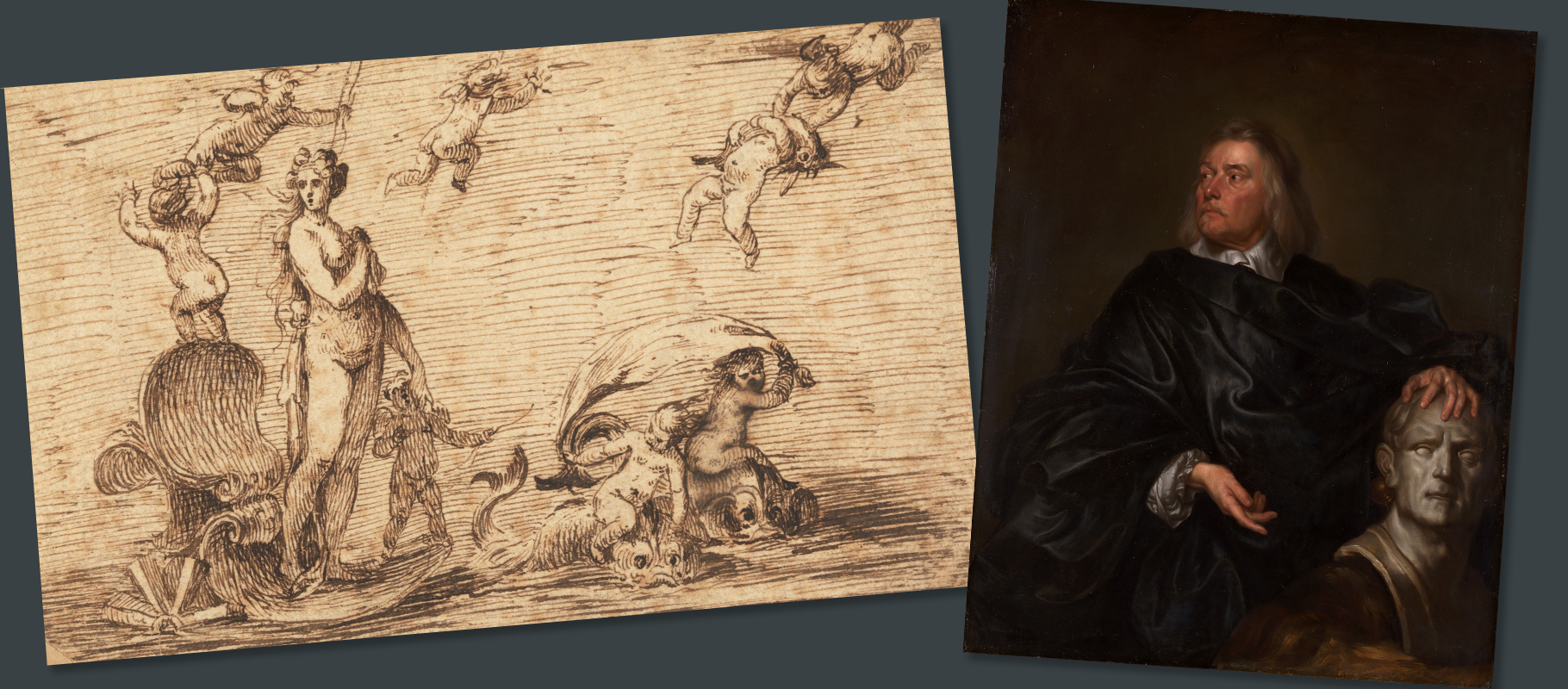 Above: drawing by Isaac Fuller and a portrait of Isaac Fuller by Edward Pierce, 1670
Above: drawing by Isaac Fuller and a portrait of Isaac Fuller by Edward Pierce, 1670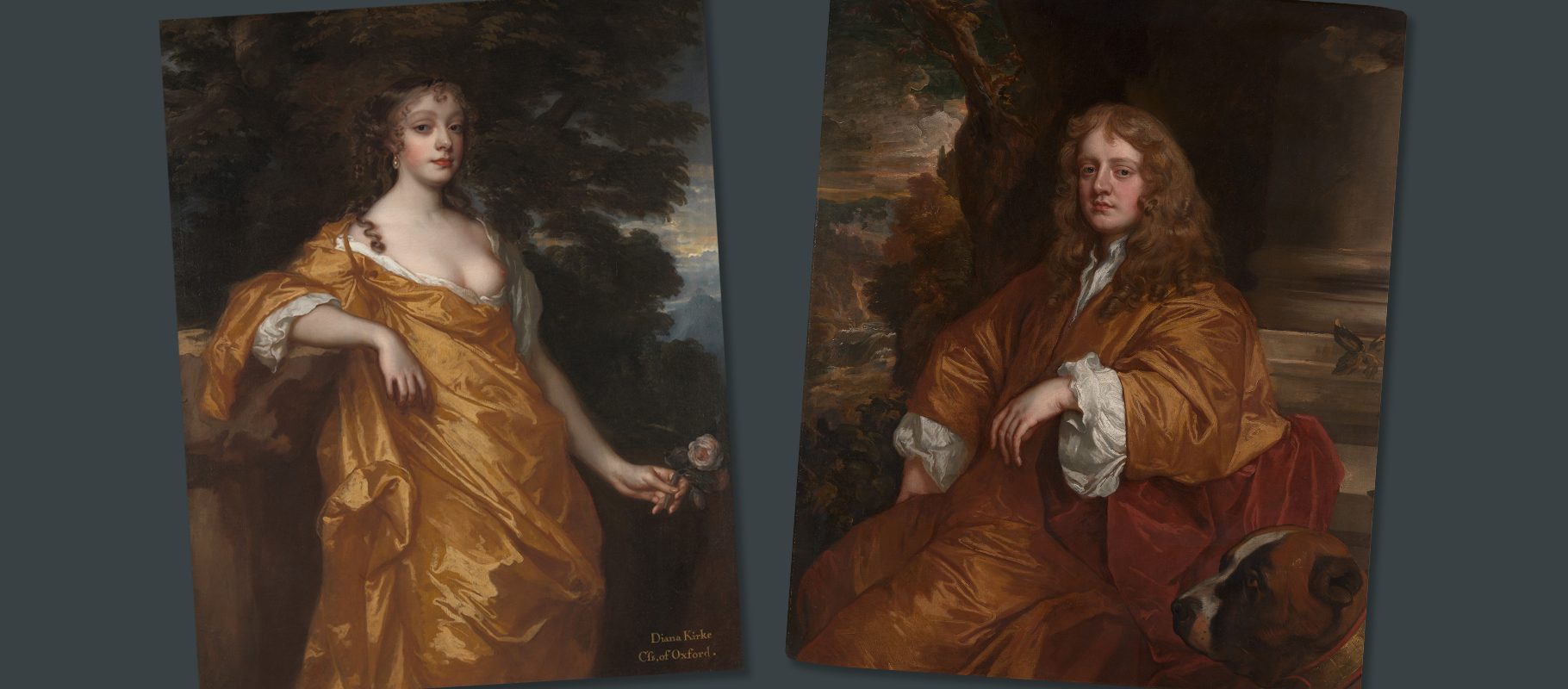 Above: two portraits by Peter Lely, Diana Kirke Countess of Oxford (1665) and Sir Ralph Bankes (1660)
Above: two portraits by Peter Lely, Diana Kirke Countess of Oxford (1665) and Sir Ralph Bankes (1660)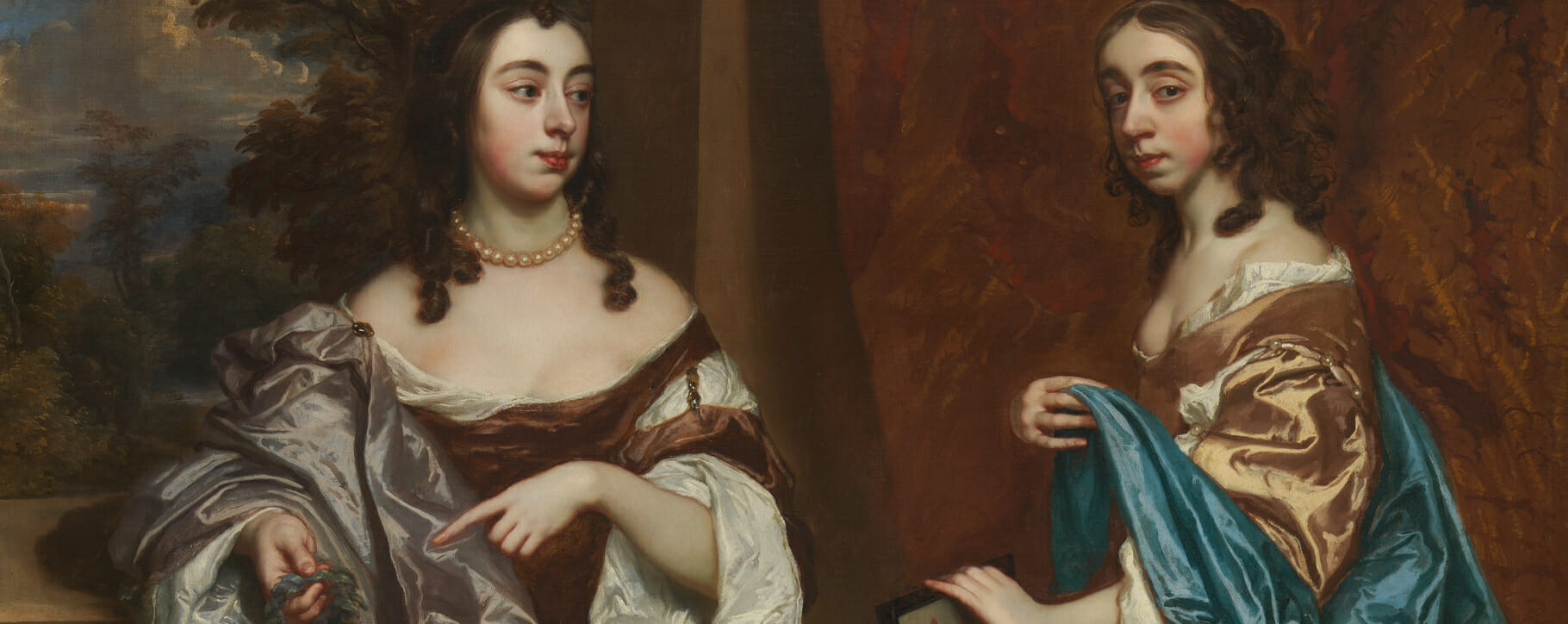 Above: detail from portrait of Mary Capel and her sister Elizabeth by Peter Lely, mid 17th century
Above: detail from portrait of Mary Capel and her sister Elizabeth by Peter Lely, mid 17th century Above: two paintings by Mary Beale and a portrait of the artist (centre) with her son Charles
Above: two paintings by Mary Beale and a portrait of the artist (centre) with her son Charles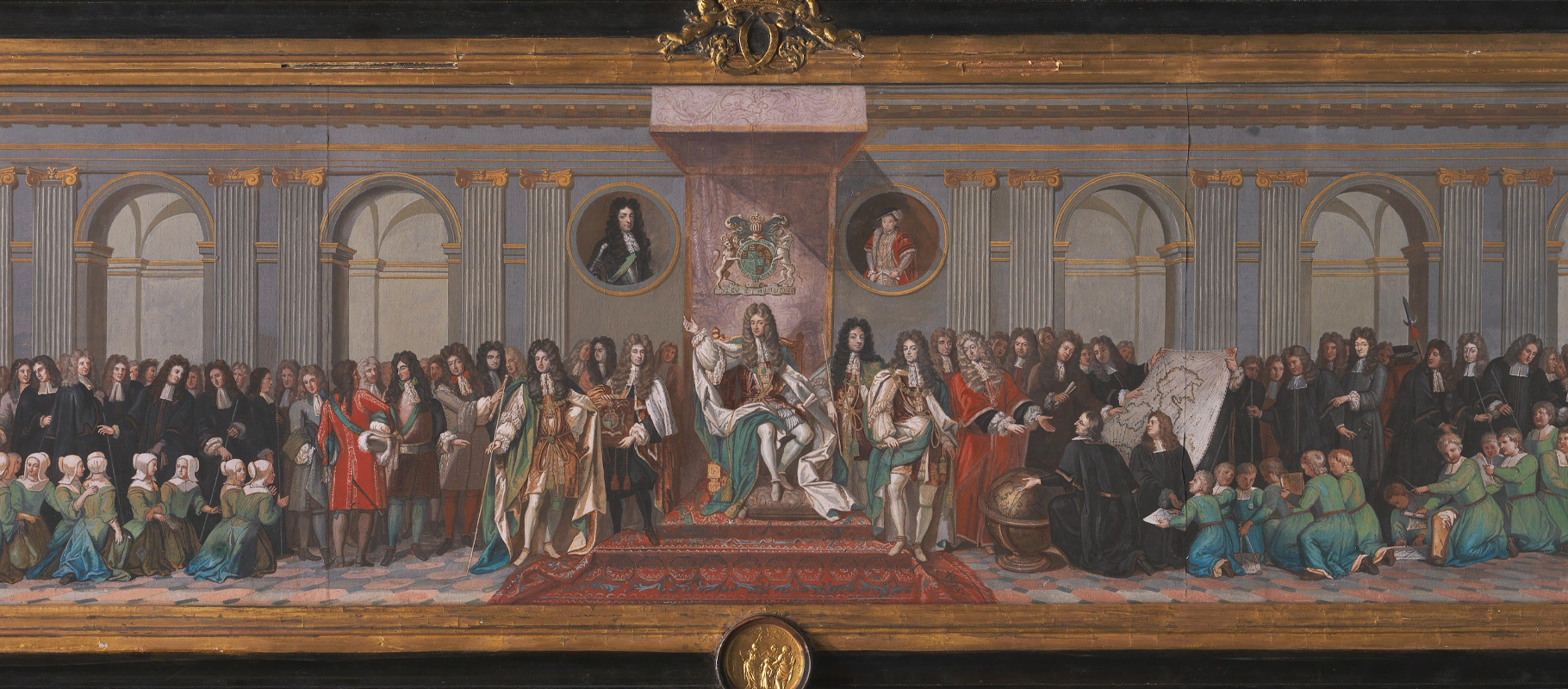 Above: close up of James II Receiving the Mathematical Scholars of Christ’s Hospital by the studio of Antonio Verrio
Above: close up of James II Receiving the Mathematical Scholars of Christ’s Hospital by the studio of Antonio Verrio Above: a pastel portrait of Phillip Woolrich by John Greenhill and two miniatures by Peter Cross
Above: a pastel portrait of Phillip Woolrich by John Greenhill and two miniatures by Peter Cross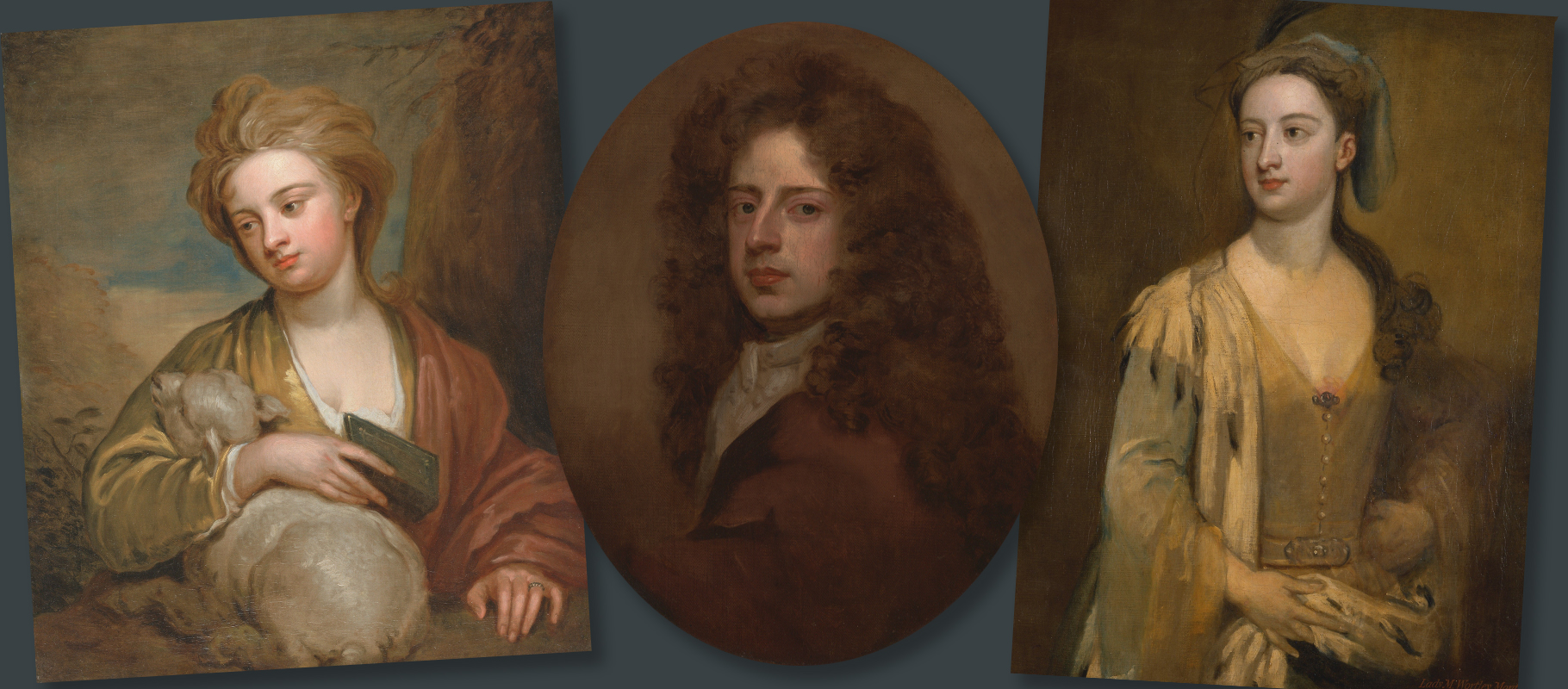 Above: three paintings by Kneller including a self portrait (centre) from 1672-73
Above: three paintings by Kneller including a self portrait (centre) from 1672-73 Above: three mezzotints after portraits by Godfrey Kneller
Above: three mezzotints after portraits by Godfrey Kneller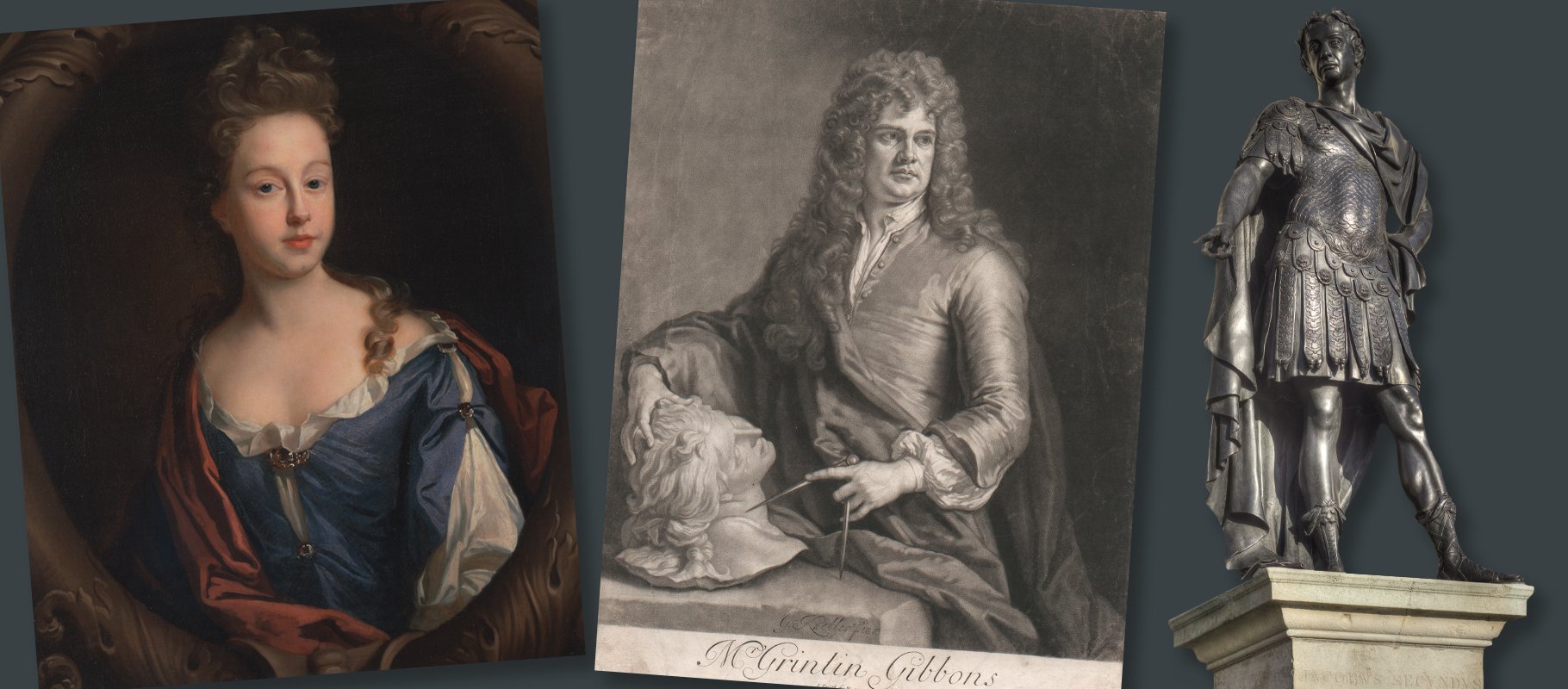 Above: a painting by John Riley, mezzotint portrait of Grinling Gibbons after Kneller, and one of Gibbons statues depicting James II in the style of a Roman emperor
Above: a painting by John Riley, mezzotint portrait of Grinling Gibbons after Kneller, and one of Gibbons statues depicting James II in the style of a Roman emperor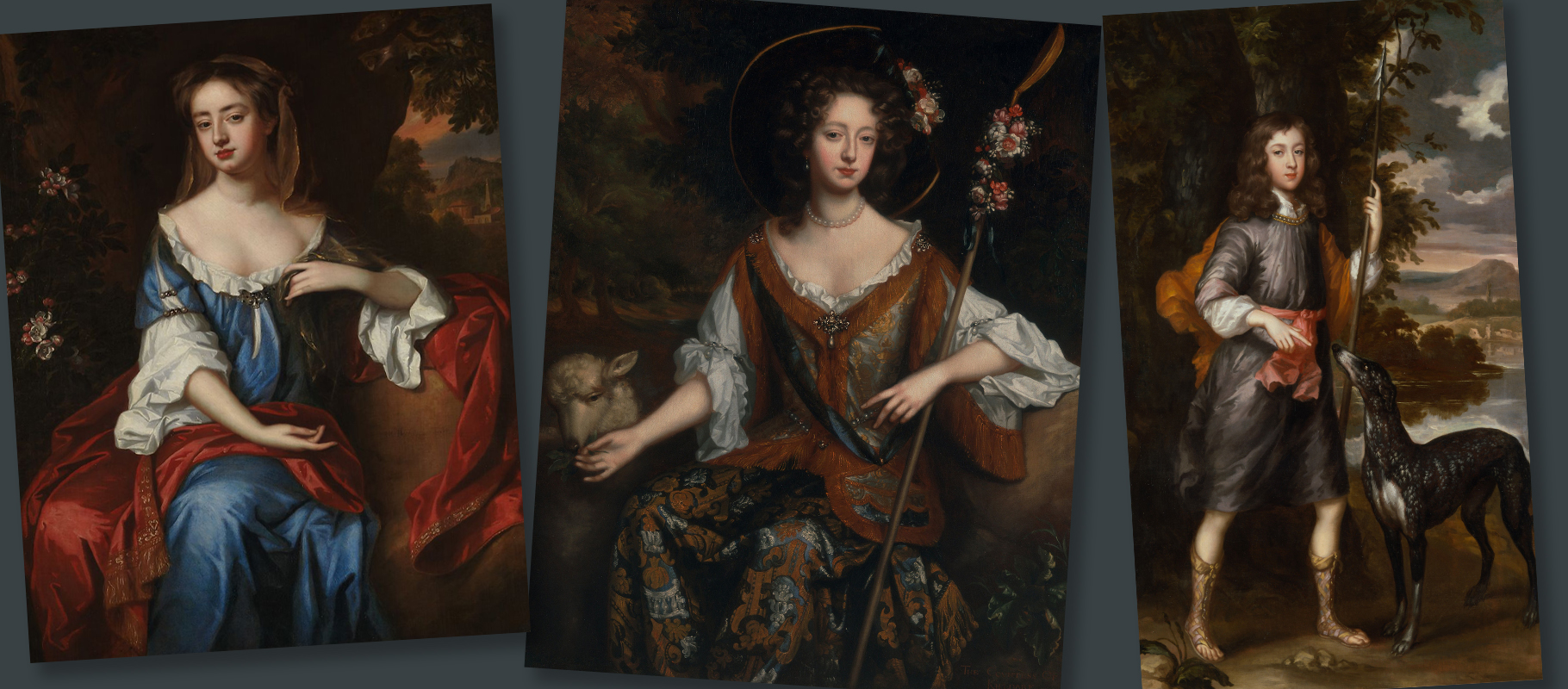 Above: three portraits by Willem Wissing
Above: three portraits by Willem Wissing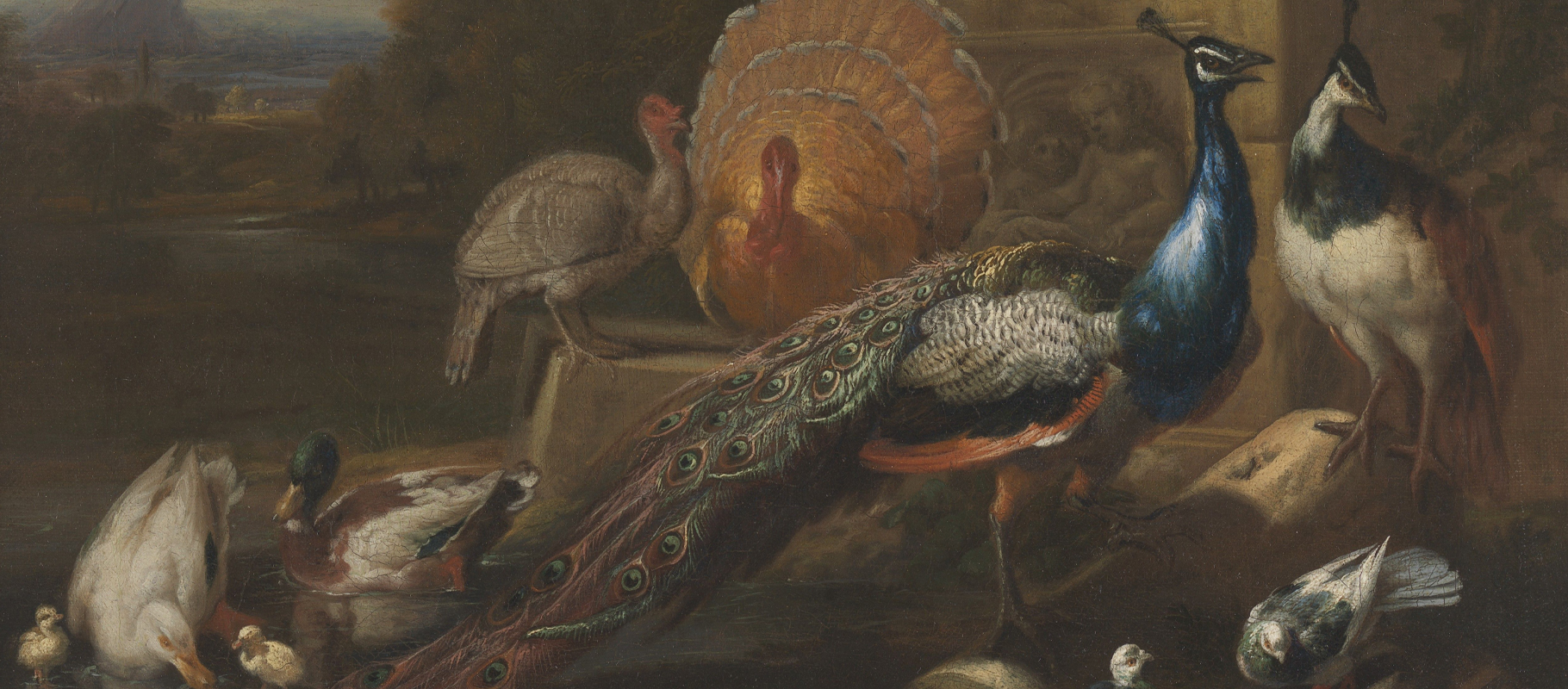 Above: detail from a painting by Marmaduke Cradock, 1700
Above: detail from a painting by Marmaduke Cradock, 1700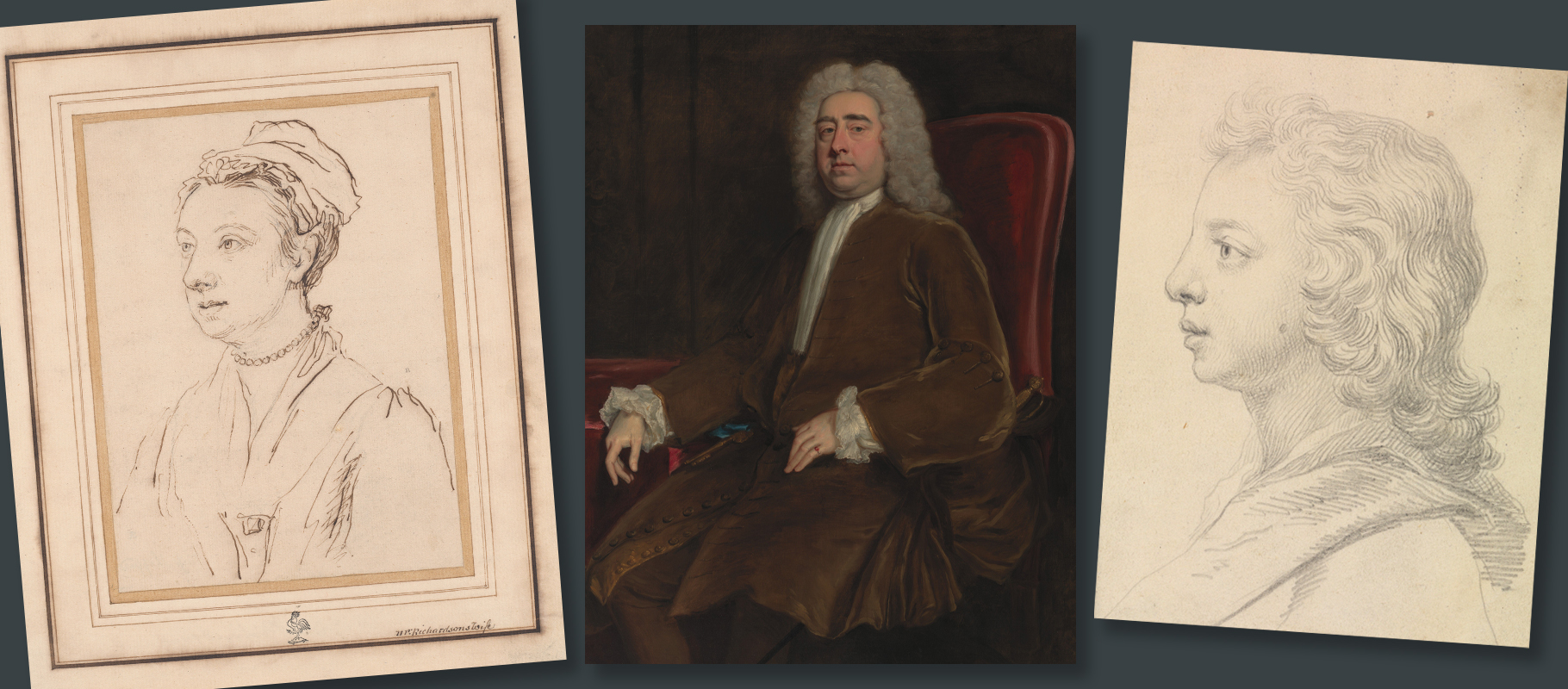 Above: three portraits by Jonathan Richardson
Above: three portraits by Jonathan Richardson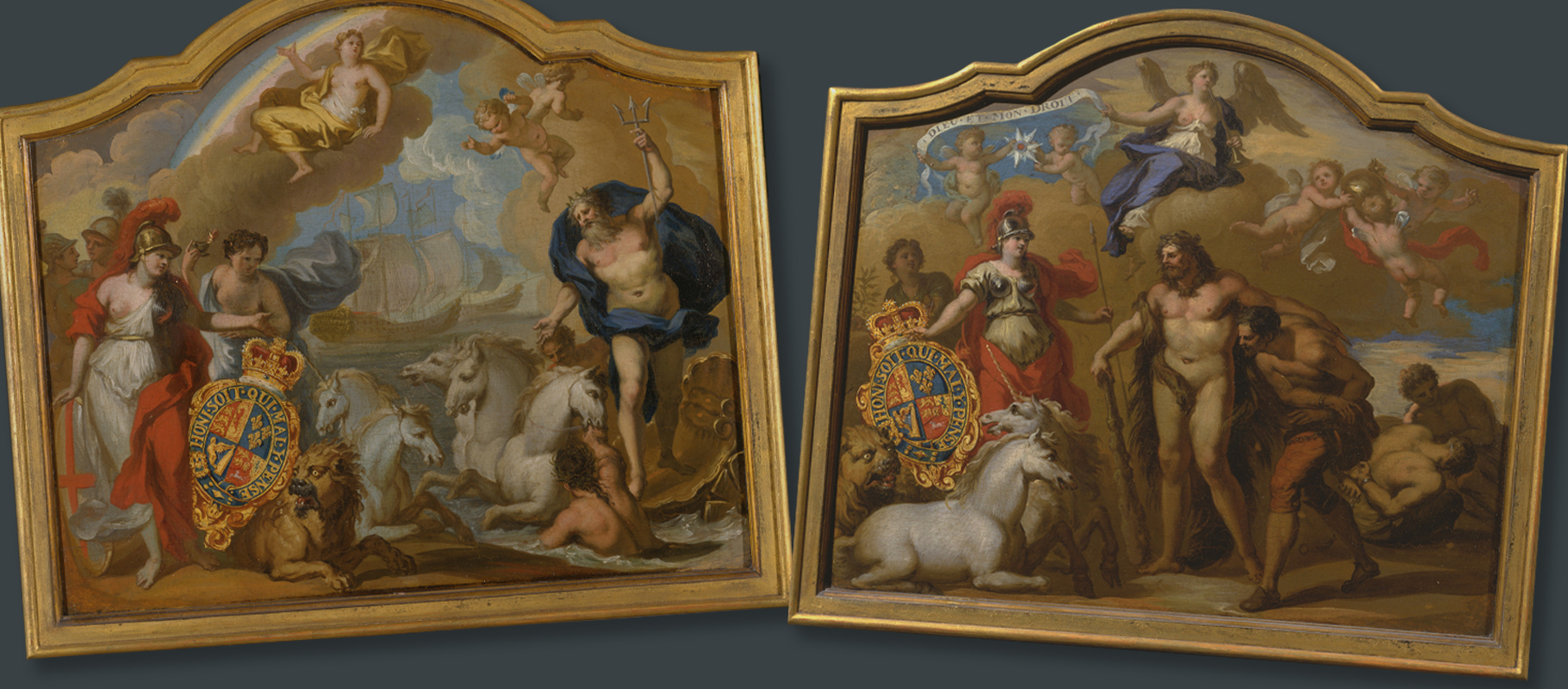 Above: two allegorical paintings attributed to James Thornhill depicting the power of Great Britain by sea and land, 1720
Above: two allegorical paintings attributed to James Thornhill depicting the power of Great Britain by sea and land, 1720




